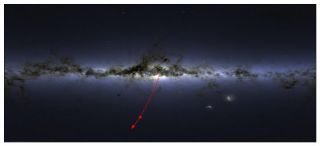A Star Ejected from the Milky Way’s ‘Heart of Darkness’ Has Reached a Mind-Blowing Speed – Space.com
As humankind’s ancestors were learning to walk upright, a star was launched out of the supermassive black hole at the center of our galaxy at a staggering 3.7 million mph (6 million km/h).
Five million years after this dramatic ejection, a group of researchers, led by Sergey Koposov of Carnegie Mellon University’s McWilliams Center for Cosmology, has spotted the star, known as S5-HVS1, in the Crane-shaped constellation Grus. The star was spotted traveling relatively close to Earth (29,000 light-years away) at unprecedented, searing speeds — about 10 times faster than most stars in our galaxy.
“The velocity of the discovered star is so high that it will inevitably leave the galaxy and never return,” Douglas Boubert, a researcher at the University of Oxford and a co-author on the study, said in a statement.
Related: Top 10 Star Mysteries of All Time

An artist’s impression of te star S5-HVS1 being ejected by the Milky Way galaxy’s supermassive black hole, Sagittarius A*.
(Image credit: James Josephides (Swinburne Astronomy Productions))
“This is super exciting, as we have long suspected that black holes can eject stars with very high velocities. However, we never had an unambiguous association of such a fast star with the galactic center,” Koposov said in the statement.
The star was discovered with observations from the Anglo-Australian Telescope (AAT), a 12.8-foot (3.9-meter) telescope, and the European Space Agency’s Gaia satellite. The discovery was made as part of the Southern Stellar Stream Spectroscopic Survey (S5), a collaboration of astronomers from Chile, the U.S., the U.K. and Australia.
Now that the star has been spotted, researchers could track the star back to Sagittarius A*, the black hole at the center of the Milky Way. It also serves as an incredible example of the Hills Mechanism, proposed by astronomer Jack Hills 30 years ago, in which stars are ejected from the centers of galaxies at high speeds after an interaction between a binary-star system and the black hole at the center of the galaxy.

The location and direction of the star S5-HVS1 in the night sky. The star is rocketing away from the center of our galaxy.
(Image credit: Sergey Koposov)
“This is the first clear demonstration of the Hills Mechanism in action,” Ting Li, a fellow at the Carnegie Observatories and Princeton University who led the S5 collaboration, said in the statement. “Seeing this star is really amazing as we know it must have formed in the galactic center, a place very different to our local environment. It is a visitor from a strange land.”
“While the main science goal of S5 is to probe the stellar streams — disrupting dwarf galaxies and globular clusters — we dedicated spare resources of the instrument to searching for interesting targets in the Milky Way, and voila, we found something amazing for ‘free.’ With our future observations, hopefully we will find even more!” Kyler Kuehn, deputy director of technology at the Lowell Observatory who is part of the S5 executive committee, added in the statement.
This discovery was published in a study on Nov. 4 in the journal the Monthly Notices of the Royal Astronomical Society.
Follow Chelsea Gohd on Twitter @chelsea_gohd. Follow us on Twitter @Spacedotcom and on Facebook.





